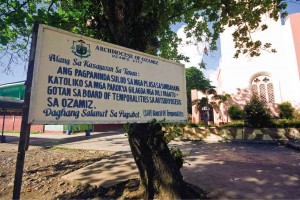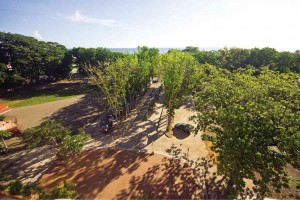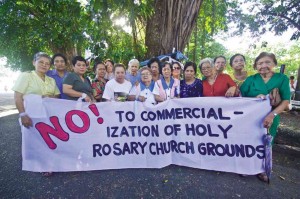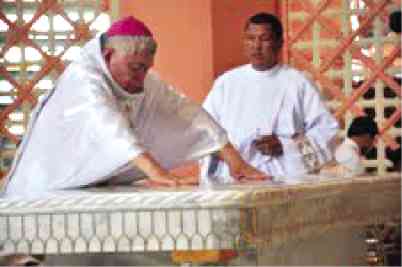
OROQUIETA CITY, MISAMIS OCCIDENTAL—Archbishop Jesus A. Dosado of the Archdiocese of Ozamiz has given the Parish of the Holy Rosary in this city an ultimatum: Give the archdiocese P50,000 a month, or the archdiocese will cut the ancient acacia trees in front of the church and convert the church grounds into a commercial zone that will house a popular fast-food chain and a bank.
And that’s even a discounted amount.
“He originally mentioned P75,000,” said one of the five parish elders who were in the meeting with Dosado at the Archbishop’s Residence in Catadman in nearby Ozamiz City last April 2.
The parish elders were Carmen Montalvan, past president of the Catholic Women’s League (CWL), both Oroquieta chapter and the archdiocesan level; Libertad Tulen, the current CWL president; Clotilde Gonzales, first vice president of the CWL and member of the Mother Butlers’ Guild; and the couple Soceso and Angelina Lim, active parishioners who are respected members of the business community (he is a senior member of the Knights of Columbus, or K of C).
“I have nothing to say,” Dosado told this reporter. “I have not made a decision.”
A priest of the archdiocese who refused to be identified said the plan to build a commercial strip at the Oroquieta City church grounds had been announced during the monthly clergy meeting last February.
Fr. Marvin Osmeña, who heads the archdiocese’s Board of Temporalities, which serves as the ways-and-means committee of the archdiocese, confirmed this when parish leaders and concerned parishioners met with him.
“Fr. Osmeña said they don’t actually have any funds for the medical costs of the priests, and most of the priests are 50 years old and above,” said Dr. Karen Conol-Salomon, a physician who was in that meeting. “A couple of them are on dialysis, one just had a pacemaker surgery, and almost all of them are on maintenance meds, such as for high blood and diabetes.”
Fr. Osmeña reportedly said two establishments they were negotiating with as lessees for the planned commercial zone on church grounds in Oroquieta City were Jollibee and First Valley Bank.

He also said the church grounds in Tangub City would also be leased by SeaOil in a similar lease arrangement.
“We wanted to discuss the matter with our parish priest, Fr. Arnold Daplin,” said Montalvan, who is CWL consultant. “But he was off to the Holy Land for a Holy Week retreat.”
In a write-up she prepared to read before the priests in the clergy meeting (but which she was not allowed to do so), Montalvan said: “We wish to express the deep sorrow and pain that we feel about losing our church plaza to the destructive hands of commercialization. We all remember the peace and joy of coming together as one family during the countless religious and civic celebrations [held there]. It is the center of life for all of Oroquieta.”
“The Via Crucis [Stations of the Cross] as well as the Easter rites and rituals of the Sugat [the ceremonial meeting of Mary and the Risen Christ], the Hugos [the hoisting of ‘angels’ singing the ‘Alleluia’]; and the blessing of fire and water have always been held here, and now they will allow the church grounds to be desecrated by commercialization,” said Gonzales.
Needless beautification
The Holy Rosary Church has just celebrated its 125th year last December. In time for this, the parish priest raised funds to renovate the church.
“How come we were made to raise millions of money for the church beautification which we never asked and never wanted?” Conol-Salomon said. “Sayang, those millions would have gone to the medical funds of the archdiocese and not to be wasted on some beautification. We have already been squeezed with all the solicitations for a project we do not want. People in Oroquieta are conservative and simple. We don’t want anything showy. If only you had presented it to the parishioners, do you think the people won’t help you?”

When Fr. Daplin took over the parish six years ago, among the first things he did was to ask the Parish Pastoral Council (PPC) to use the funds it collected for the construction of a seminar house so that he could buy a sound system worth P1 million, said parish leaders. The PPC refused his request. Afterward, he dissolved the PPC’s finance committee and put up his own solicitation team independent of the PPC.
Fr. Daplin eventually changed the name of the solicitation team to Service Team.
Nonetheless, the team kept on hounding the parishioners for funds, and the parish priest pursued fund-raising projects for one thing or another. “After one project, there would be another project,” said another parishioner.
“Fact is, all his beautification projects of the church are not necessary because the church is beautiful as it is. Now it has lost its particular charm and looks just like any church,” said another parishioner.
“Fr. Daplin even transferred the ownership of the new Catholic cemetery in Upper Lamac to the archdiocese when the land was bought by the pioneering members of the Knights of Columbus using their personal money,” said a descendant of one of the original K of C members.
As the archdiocesan chaplain, Fr. Daplin is always out of town, leaving the parish to assistants.
Parishioners have come up with posters, billboards, streamers and tarps protesting the turn of events: “Mag-rosaryo ta, dili mag-negosyo (Let us pray the Rosary, not do business here).” “No to commercialization of the Holy Rosary Parish grounds.” “Yuta sa Katoliko, dili i-negosyo (This is Catholic church grounds, not a marketplace).”
Concerned parishioners tied blue and white ribbons on the ancient acacia trees and other trees on the church grounds. They themselves wear blue and white ribbons on their wrists to signify their protest. To further dramatize their resistance, they put blue and white ribbons on their gates and doors in their homes.

“We have been waiting for subsequent meetings with the archdiocese leaders, but it seems they are giving us the runaround and playing for time. By ignoring us, they are also ignoring the heritage and history of our city,” said Conol-Salomon.
Historic events
Two events highlighted this city’s place in the country’s history—and these events happened at the church grounds.
The first was the daring attack on American forces stationed at the parish convent during the Philippine-American War. Armed with newly sharpened bolos, kampilans, long hunting knives, spears, and some old model guns called tercerola, the Filipino soldiers followed the command of General Rufino Deloso in a dawn attack.
But the American soldiers were better equipped and, with the help of a warship anchored on the nearby shore, were successful in subduing the Filipino forces. By noon, 117 of the Filipino soldiers lay dead on the church grounds. They were buried at the back of the church by the lone survivor who was captured.
The second event was the arrival of President Manuel L. Quezon and his party on the shores of Oroquieta, making landfall after many days at sea following their harrowing escape from Manila during World War II.
Quezon declared Oroquieta as “The Capital of the Free Philippines” before proceeding to Australia.
Over the years, the church grounds, which spill out into the plaza that meanders into the sea, has become part of the Oroquieta experience.
“It has become a landmark in our collective imagination,” noted Felicidad Corcino, who grew up here but now lives in Davao City. “It is the familiar vista that makes us feel we are home.”
A petition letter that has so far gathered over 10,000 signatures stressed four points, namely: the preservation of the sacredness of the church grounds; preservation of the trees on the church grounds, particularly the age-old acacia trees considered as “landmarks of Oroquieta”; preservation of the views that the open space affords—all the way to the sea; and observance of the city’s approved zoning ordinance which considers the church grounds as an institutional zone, not a commercial zone.
Many signatures were gathered online through the Facebook account “Save the Holy Rosary Church of Oroquieta, Save the Acacia Trees.”
“We are willing to raise the P50,000 per month the archbishop is asking from us,” said Montalvan. “I told them that I am going to spend the last years of my life supporting the archdiocese and its financial needs as long as they will not pursue their plans.”









































